Market Outlook Quarterly Q3 2022

-
Macro-economic Conditions are shifting and affecting the residential construction sector. This gives nonresidential and infrastructure construction room to grow. The escalation ranges below depend on both local and general conditions for these sectors
-
Low-Range – 1.0% per quarter to midpoint assumes the Federal Reserve rate hikes will cool construction demand quickly and we return to historical construction escalation rates thru to midpoint
-
Mid-Range – 1.5% per quarter to midpoint assumes the Federal Reserve rate hikes will take some time to cool construction demand and we will remain at above average construction escalation rates thru to midpoint
-
High-Range – 2.0% per quarter to midpoint assumes the Federal Reserve rate hikes will not materially affect construction demand, even though they have cooled inflation in the economy. Construction escalation rates will remain high thru to midpoint
-
Construction Prices rose in Q2 and Q3 of 2022 at 0.75% per month
-
Supply Chain Shortages, labor shortages, and increased backlogs are impacting bid prices. However, the supply chain and fear of recession have reduced the cost impact of these factors
-
Fed Watch: The Federal Reserve has increased interest rates 0.75% in line with plans to continue increases in rates and continue to tighten quantitative measures
-
Architectural Billings' growth declined from a high of 58 in March to 53.3 in August along with a fall in contracts. A rating above 50 means continued growth
-
Construction Dollar Volume: residential construction growth slowed down in Q3; nonresidential construction is up 9.7% annually, and infrastructure spending increased 1.06% this quarter
-
Construction Job Growth: approximately 51,000 construction jobs were added in Q3, or +0.67%; construction employment is now 1.25% above pre-pandemic levels
-
New York Stock Exchange has dropped 17.62% from year over year
-
Growth in Employment: monthly average job growth through Q3 was 352K peaking in July with 537k before falling to 315k in August
-
Gross Domestic Product: GDP dropped from Q1 2022 to Q2 2022 for the first time since the onset of the pandemic. GDP in Q2 2022 decreased by 0.6% in Q2 and Q3 estimates are a 2.6% increase in GDP
-
Commodities continue to put cost pressure on prices but show signs of moderating
Fed Watch
Inflation and Employment Targets propel monetary policy, and subsequently construction prices. Current inflation is running at 6 to 8 percent. Yearend inflation is expected to be 5.4%. This has propelled quantitative tightening and a series of fed fund rate hikes to 3-3.25 percent. Yearend Fed funds rate is expected to be 4.4 percent.
“In this cycle, longer run inflation expectations have been well anchored. To the extent that this continues, that should make it easier to restore price stability. Also, different this time, is that part of this inflation is caused by supply shocks, beginning with the pandemic, then with the opening of the economy, then with Russia’s invasion of Ukraine.”
https://www.federalreserve.gov/mediacenter/files/FOMCpresconf20220921.pdf
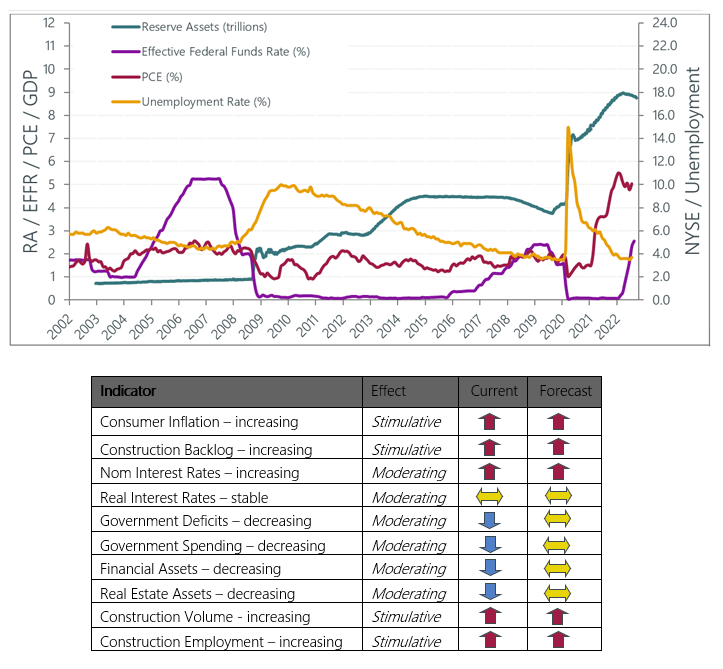
Vermeulens Construction Cost Index
Price increases for Q2 and Q3 2022 nationally increased to 0.75% monthly as contractor backlogs filled, and labor/material shortages continued.
For the past 34 years, nonresidential construction prices trended at a 3.6% annually compounded escalation rate. The rate of escalation seen in construction costs relate to the target of 2% annual inflation for consumer prices and the monetary policy used to achieve this goal. Consumer inflation has increased rapidly to the long-term target of 2%.
In contrast to previous financial recessions, strong and immediate fiscal and monetary measures countered the collapse in activity at the outset of the pandemic. We are now at the turning point where these measures are reversing due to the overwhelming strength of major indicators.
The chart below illustrates bid prices for nonresidential construction projects relative to the Construction Trendline (1986 = 100) of 3.57% and the 1.7% Personal Consumption Expenditures Index Trendline. Strength in the construction sector point to short term cost increases of 0.75% per month, and a continuing increase in the long term Vermeulens Trendline toward 4%.
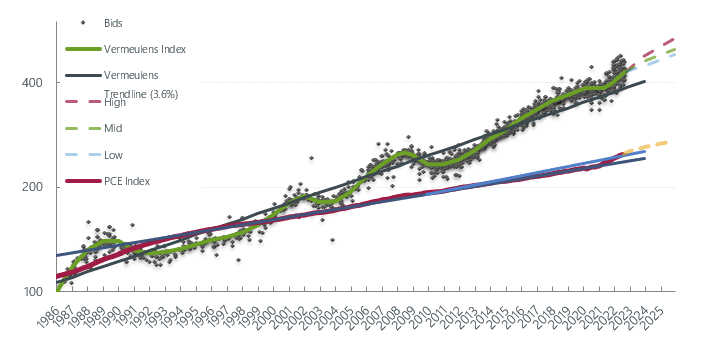
AIA Billings
Architectural Billings are a leading indicator for future construction volume. A score greater than 50 indicates growth. Design fee billings typically indicate construction volume 9 - 12 months in advance.
Architectural Billings and inquiry growth continued at a slow pace. The value of new signed design contracts also fell to the slowest pace of growth since January 2021. https://www.aia.org/
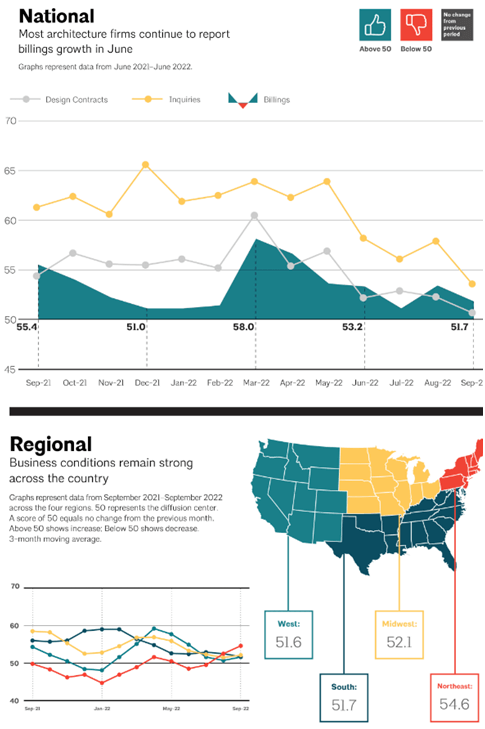
Put In Place Construction
Construction Dollar Volume declined in Q3, posting an 11.6% year over year increase (Aug 21/Aug 22). Construction dollar volume is the main driver of construction prices.
Residential dollar volume growth slowed down, improving year over year by 16.8% (Aug 21/Aug 22).
Nonresidential spending is up 9.7% year over year (Aug 21/Aug 22). Improved backlogs, attrition, and shortages are driving price increases in this sector.
Infrastructure spending increased 1.06% since Q2 2022, with a 2.2% year over year change (Aug 21/Aug 22). Federal infrastructure spending will increase over the next 10 years. See https://vermeulens.com/blog/fiscalwatch for an impact assessment of new programs.
“The interest sensitive parts of the economy are certainly showing the effects of our tightening. Housing is seeing declining activity and house prices are moving down. Through exchange rates we are having an effect on imports and exports.”
https://www.federalreserve.gov/mediacenter/files/FOMCpresconf20220921.pdf
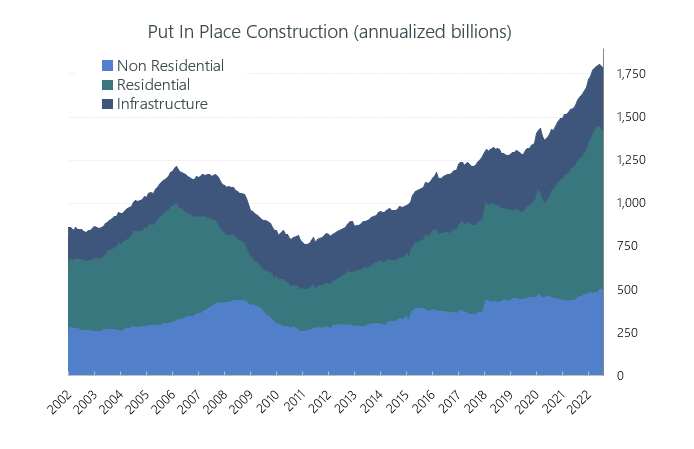
http://www.census.gov/construction/c30/c30index.html
Commodity Prices
Crude Oil reached $79.91 per barrel at the end of September 2022. Prices decreased relatively throughout the quarter, peaking at $110.30 on July 1st.
Structural Steel prices through Q2 2022 increased from Q1 2022 levels. Structural sections and beams remained the same and rebar is down by 0.08% since March 2022. Steel futures indicate a gradual return in prices by 2022.
“Supply chain events are not really part of business cycles, and we do see some evidence of stability. Commodity prices look like they might have peaked for now.”
https://www.federalreserve.gov/mediacenter/files/FOMCpresconf20220921.pdf
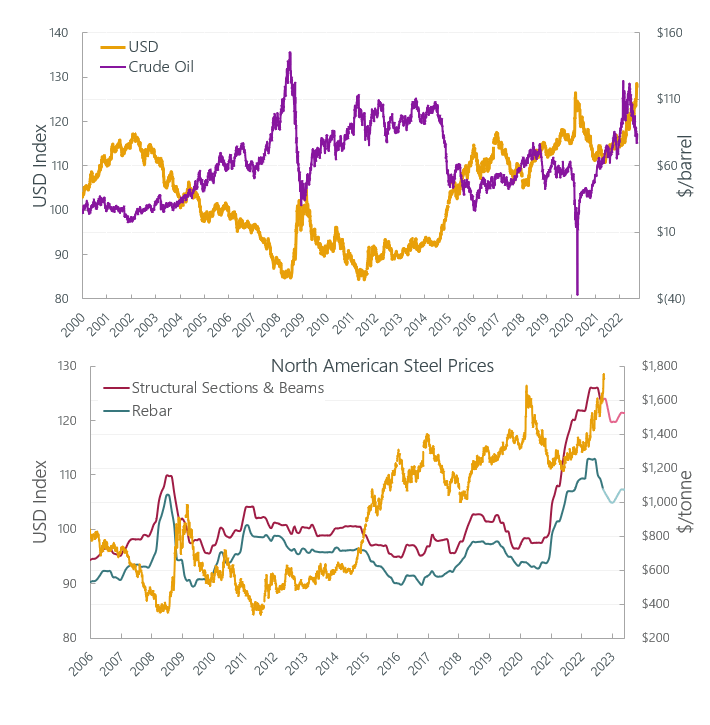
Construction Labor Market
Construction Unemployment at the end of Q3 sits at 4.7% (12-month average), down from 5.3% at the end of Q2, reflecting a lack of increase in labor supply.
Construction Job Growth was 51,000 or 0.67%, this quarter. Wage and profit increases in the non-residential sector will draw new entrants, as well as restructuring from the residential sector and other sectors of the economy. Labor growth is likely to continue its steep rise as selling prices in the sector outperform other industries.
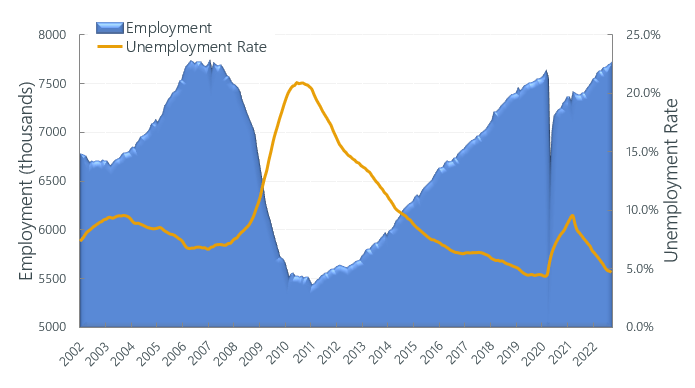
Construction Labor Force Growth Rate
Construction Labor Force Growth Rate is calculated by the current 12-month average in construction employment relative to previous 12-month average in construction employment.
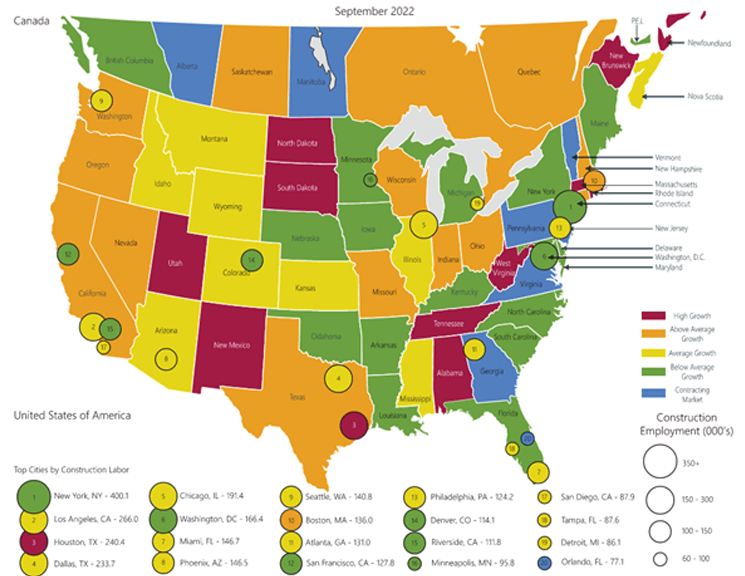
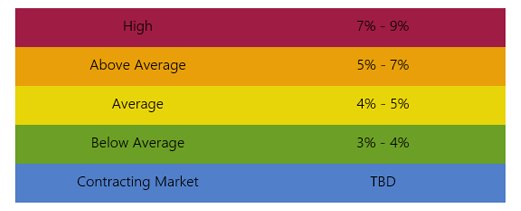
Total Jobs and Market Performance
Monthly Average Job Growth for the US economy through Q3 was 352K peaking in July with 537k before falling to 315k in August.
“There is modest evidence that the labor market is cooling off. Job openings are down a bit, quits are off their all-time highs; wage measures may be flattening; payroll gains have moderated but not much.
It’s plausible that job openings will come down significantly without much increase in unemployment as has happened in earlier historical episodes.”
https://www.federalreserve.gov/mediacenter/files/FOMCpresconf20220921.pdf
The chart below removes short-term fluctuations in job growth by looking at a 6-month moving average. The size of the labor force grows at 100,000 per month due to population increase. Sustained periods of recession, where job creation remains below 100,000 jobs per month, has accompanied dips in construction prices as illustrated by the red bars below.
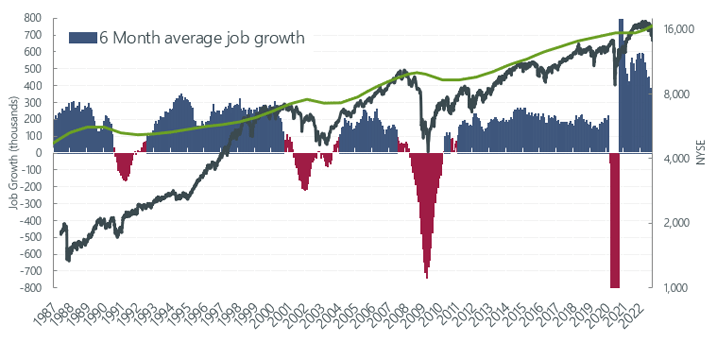
https://data.bls.gov/timeseries/CES0000000001
Employment Percentage of Total Workforce
Total Employment as a percentage of total workforce continued its recovery reaching more than 92% at the end of Q3 2022.The chart below shows total employment as a percentage of the US workforce. The Federal Reserve will accommodate growth to maximize employment. Both the size of the labor force and participation rates are at play, as we have seen in recent months, where labor force growth has not kept pace with employment opportunities, resulting in shortages. See Vermeulens’ blog, The Feds New Normal for more analysis of employment and labor force factors.https://www.federalreserve.gov/monetarypolicy/files/monetary20220316a1.pdf“The chances of a soft landing are likely to diminish to the extent that policy needs to be more restrictive or restrictive for longer. Vacancies and quits are very good ways to look at how tight the labor market is and how different it is from other cycles, where the unemployment rate was the single best indicator.”
https://www.federalreserve.gov/mediacenter/files/FOMCpresconf20220921.pdf
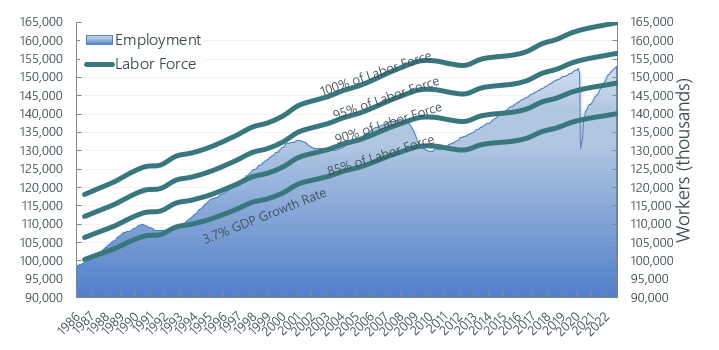
Forecast - National Trend
Nonresidential Construction prices rose in Q3 of 2022 at 0.75% per month following a 0.5% per month rate in the second half of 2021. Contractor backlogs stabilized along with expectation of strong margins, increased labor costs, and upward volatility in supply prices. Medium term construction price inflation is forecasted at 9% for 2022, and 6% for 2023 before settling to a long-term average of 4%. This aligns with Federal Reserve forecasts for inflation of 5.4% this year, 2.8% next year, 2.3% in 2024, and 2% in 2025.
“By slowing the economy, and some softening in the labor market, and a big contribution from supply-side improvements, (we could achieve inflation objectives without negative economic growth and sustained job losses).”
https://www.federalreserve.gov/mediacenter/files/FOMCpresconf20220921.pdf
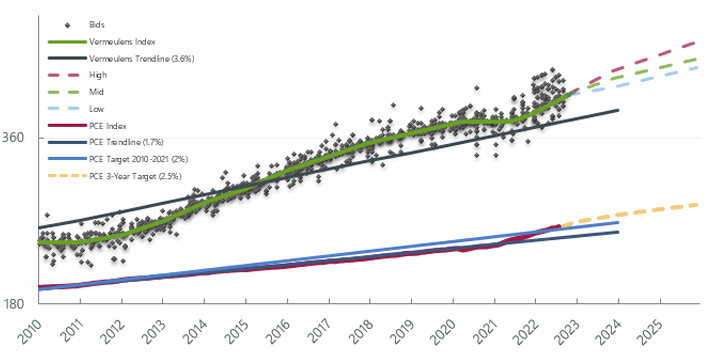
Vermeulens strives to give our clients the greatest possible value and results for their projects. If you:
Need any help with your projects,
Want to set up a presentation to your group,
Would like to meet to see how we can help your team, and expand our business together,
Are looking for company information,
Please contact: Marisol Serrao, Principal at 617 263 8879 or mserrao@vermeulens.com.









